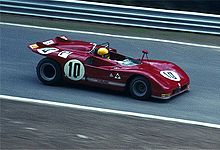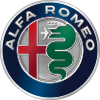Alfa Romeo Tipo 33
Tipo 33 is the name of a series of prototype sports cars by the Italian car manufacturer Alfa Romeo , which were created for racing purposes in its motorsport department Autodelta between 1967 and 1977. A wide variety of Tipo 33 variants have been produced over the years. The mid-engine concept was common to all Tipo 33s, but the engines, bodies and wheelbases could vary. Alfa Romeo took up the designation "33" again in 1983 for the mass-produced compact sedan Alfa Romeo 33 , which replaced the Alfasud .
Tipo 33/2
It all began in 1967 with the Tipo 33/2 with a 2.0 and 2.5 liter V8 engine, 16 spark plugs , four overhead camshafts and a maximum speed of around 10,000 rpm. The chassis initially consisted of an H-shaped central structure, which was riveted from aluminum half-shells, and electron cast structures also riveted to it at the front and rear. The front structure, which forms the occupant's footwell and accommodates the front wheel suspension, was an extremely complex, cage-like component. In addition to the engine, two cone-like cast parts formed the connection to a rear bulkhead that supported the clutch bell - a design common in racing. In terms of casting technology, these three components are a remarkable technical achievement, especially at the time. Later 33 variants had a tubular space frame , from which the designation "TT" for "Telaio (chassis) Tubulare (tubular)" is derived. In the 2.0-liter version, the car developed 270 hp, weighed 580 kg and reached a top of 298 km / h. In the same year, the car won the Fléron hill climb in Belgium. Among other things, the Tipo 33/2 took the first three places in its category in the Le Mans 24-hour race the following year . A total of 30 copies were made.
The 33/2 was used in numerous sports car races around the world until the 1970s. In 1973, for example, the Portuguese racing driver Fernando Coelho started a 33/2 in Angola for the 3-hour race in Luanda .
Tipo 33 Stradale
The factory model
In order to make racing technology accessible to the public, the Tipo 33 Stradale, which is suitable for road traffic , was also brought onto the market in 1967 at the Turin Motor Show . Franco Scaglione designed the 230 hp vehicle and it was built by Marazzi . The otherwise rare butterfly doors are a special design element .
The car was very powerful. With a total weight of 700 kg, the Stradale accelerated to 100 km / h in 5.5 seconds. The advertisement said about the car: "A superficially domesticated racing car with street legal approval". The selling price was extremely high, and for this reason only a few were sold until 1969.
The scope of production is unclear. It is generally assumed that a total of 18 chassis were provided for the Stradale project. However, a maximum of 12 of them received the Scaglione body. Eight Scaglione coupes are known today. It is doubtful whether four other vehicles were dressed by Marazzi.
Special bodies
Five more T 33/2 chassis were clad with individual bodies suitable for road use, each of which remained unique. A chassis received two different structures one after the other.
Bertone Carabo
In 1968, Marcello Gandini designed the Carabo for Bertone , a wedge-shaped coupé with gullwing doors that was shown to the public for the first time at the Paris Motor Show. The car was built on chassis no.750.33.109. The name Carabo refers to the family of ground beetles (lat. Carabidae), the green-orange color of which the Carabo took up. The Carabo had a pronounced wedge shape and is one of the first vehicles with scissor doors . The shape of the car anticipated some features of the Lamborghini Countach introduced three years later , the body of which also came from Gandini. There were numerous slats made of black plastic on the front and rear. This detail was later found in the Lamborghini Urraco . The Carabo was ready to go when it was presented.
In 1976 Bertone manufactured the Bertone Navajo on chassis no. 750.33.117 , a solid-looking, closed coupé with angular contours and a large roll bar.
Pininfarina P 33 Sport Roadster
Between 1969 and 1971, Pininfarina designed a total of three vehicles on two T 33/2 chassis. The first draft was the P 33 Sport Roadster from 1968. It was an open vehicle with a low windscreen and a striking roll bar painted in a dark color. The vehicle was built on chassis no. 750.33.108. It was presented to the public at the Turin Motor Show in November 1968. Its whereabouts are unclear. It is sometimes assumed that the body of the P 33 was removed after the public exhibition; the chassis was provided with the body of the Cuneo two years later.
Prototipo Speciale Pininfarina
The Prototipo Speciale Pininfarina , also known as the Alfa Romeo 33.2, appeared in 1969. It was based on the chassis no. 750.33.115. and wore a striking yellow paint job. The designer in charge was Leonardo Fioravanti . The 33.2 was a rounded coupé with gullwing doors, folding headlights and an extensively glazed cockpit that picked up on a number of design ideas from various Ferrari models. Many details were particularly reminiscent of the Ferrari 250 P5 concept vehicle, which had already been shown in Geneva a year earlier . Both vehicles are regarded as "sister models"; others see the 33.2 as a further development of the 250 P5. The main differences were the design of the rear end and the pop-up headlights. The car has been in Alfa Romeo's factory museum in Arese for years .
Pininfarina Cuneo
The Pininfarina Cuneo was an open, wedge-shaped sports car that was presented at the Brussels Motor Show in January 1971 and was probably also based on chassis no. 750.33.108.
Ital design iguana
Italdesign , founded by Giorgio Giugiaro, presented the Ital Design Iguana at the Turin Motor Show in November 1969 , a closed two-seater sports coupé with an unusually high rear based on chassis no. 750.33.116. The design showed some new elements that Giugiaro took up again a few years later in various designs for series vehicles. For example, the body of the Iguana was made of brushed steel; Giugiaro later implemented this concept with the De Lorean DMC-12 . The front section of the Iguana was reminiscent of Giugiaro's designs for the Maserati models Bora and Merak , and the rear end with the high-mounted taillights was implemented in series on the Alfa Romeo Alfasud Sprint . Allegedly a series production of the Iguana was planned; however, it could not be realized.
Tipo 33/3
In spring 1969, the Tipo 33/3 with a 3.0 liter machine appeared as a supplement to the 33/2. Numerous well-known racing drivers such as Nanni Galli , Rolf Stommelen , Andrea de Adamich etc. drove the Tipo 33/2 and 33/3 on the well-known race tracks in Europe and North America in the following years. Despite the dominance of five- liter sports cars such as the Porsche 917 , the three-liter Alfa were able to achieve numerous good placements. In 1971 there were even three overall victories: Targa Florio , Brands Hatch and Watkins Glen . In 1972 a Tipo 33/4 with a 4.0 liter machine was also developed, which was used in Australia.
Tipo 33 / 3TT
At the end of 1970, the next development stage appeared with the 33 / 3TT. The abbreviation TT stands for "Telaio Tubolare", as the frame was made of aluminum tubular profiles. The driver's seat moved forward. The 33/3 TT was only an intermediate step towards the successor with a 12-cylinder engine.
Tipo 33TT12
In 1973 the Tipo 33TT12 appeared with a 12-cylinder boxer engine and 3.0 liter displacement. The engine developed around 370 kW (500 hp) at 11,000 rpm. With this vehicle, Alfa Romeo, represented by the German Willi Kauhsen Racing Team , won the sports car world championship in 1975 with seven victories in eight races. The successful drivers were Arturo Merzario , Vittorio Brambilla , Jacques Laffite , Henri Pescarolo , Derek Bell and Jochen Mass .
Tipo 33SC12
The 33SC12 appeared in 1976 as the successor to the 33TT12. The letters SC stand for "Scatolato" (Italian: la scatola = the box) to designate the box-shaped chassis. The output of the 3.0-liter 12-cylinder boxer engine has been increased to 520 hp. With this car, Alfa Romeo won the World Sports Car Championship again in 1977 with first places in all eight races. On the Salzburgring , the car reached an average speed of 203.82 km / h. A 33SC12 with two turbochargers with 640 hp was also built on a trial basis, which was only used once in Salzburg and immediately won. After that, Alfa Romeo said goodbye to sports car racing. The twelve-cylinder engine lived on in the Brabham BT46 of Bernie Ecclestone's Brabham racing team and in the Alfa Romeo 177 of the Alfa Romeo works team until 1979 .
See also
literature
- Mick Walsh: Venus de Milano . Driving report for the Alfa Romeo Tipo 33/2 Stradale, in: Classic and Sports Car , January 1999 issue
Web links
References and comments
- ↑ Style Auto . Issue 28, June 1971
- ↑ Autodelta company history in English
- ↑ Alfa Romeo Yearbook No. 6 . HEEL-Verlag, 2006, p. 30-31 .
- ↑ Mick Walsh: Venus de Milano. Driving report for the Alfa Romeo Tipo 33/2 Stradale in Classic and Sports Car, January 1999 issue: Three of them were in the USA at the turn of the century, two each in Italy and Japan, and one was in France
- ^ Illustrations by Bertone Carabo
- ↑ QV500 - Internet site: 33 Stradale Bertone 'Navajo'. Archived from the original on December 21, 2008 ; Retrieved December 7, 2012 .
- ↑ Illustration of the Sport Roadster
- ↑ QV500 - Internet site: 33 Stradale Pininfarina 'P33 Roadster'. Archived from the original on October 9, 2010 ; Retrieved December 7, 2012 .
- ↑ Images of the Alfa Tipo 33 Prototipo Speciale Pininfarina.
- ↑ Winston Goodfellow: Ferrari Hypercars , Motorbooks, 2014, ISBN 9781627885089 , p. 82.
- ↑ The Alfa Romeo 33.2 Prototipo Speciale Pininfarina on the website www.archivioprototipi.it (accessed on September 13, 2017).
- ↑ QV500 - Internet site: 33 Stradale Pininfarina 'Cuneo'. Archived from the original on December 21, 2008 ; Retrieved December 7, 2012 .
- ↑ QV500 - Internet site: 33 Stradale Ital Design 'Iguana'. Archived from the original on December 21, 2008 ; Retrieved December 7, 2012 .
- ↑ World Championship 1971 ( Memento from June 24, 2003 in the web archive archive.today )








